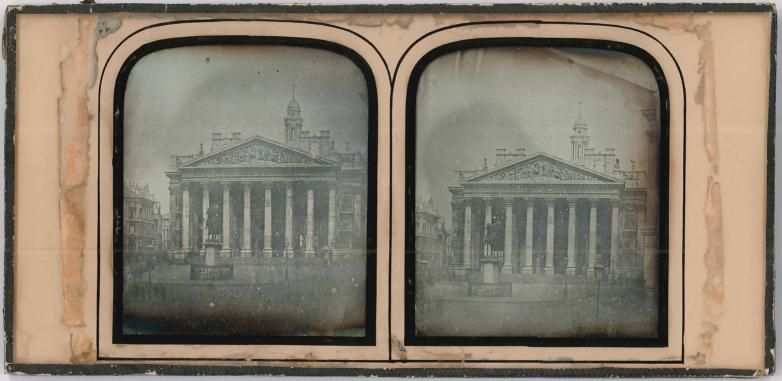Rare Camera and Early Images Head to Chiswick Auctions

One of the earliest images of the Royal Exchange in London in circa 1850. It is estimated to fetch £3,000-£5,000.
London — Chiswick Auctions is thrilled to offer an extremely rare and very early double-stroke, black paint Leica M3. This type of camera was used professionally by some of the best photojournalists of the 20th century and are extremely rare. The camera, which includes all of the features of these highly sought-after unofficial pre-series cameras, will go under the hammer in a sale of Photographica on Thursday 14th November, 2019.
This particular camera was delivered to the famous Magnum Photo Agency in Paris in 1958 as it was the chosen camera of top photojournalists at the time. Factory delivery records show that only 90 of these pre-series cameras were sent before the first official batch of black M3 rangefinders in 1959, of which this is a survivor. It is not known how many others are still in existence from such a small production number.
The majority of them were delivered to Sweden and individual deliveries were also made to Paris, New York and Germany. The serial number on the camera in the sale, records it as the 15th black paint M3 camera to have been produced, which means that it’s the second earliest example of this model ever to be offered at auction. (The earliest example, the second of the batch, sold in 2014 for £320,000 in Hong Kong). This example has a conservative estimate of £60,000-£80,000 but due to its popularity and rarity, it is expected to achieve much more.
Magnum Photographic Agency is one of the first photographic cooperatives, owned and administered entirely by its photographers. It was founded in 1947 by famous Photographers such as Robert Capa, David "Chim" Seymour, Henri Cartier-Bresson, George Rodger and William Vandivert. These were some of the most influential and pioneering photojournalists of the 20th century. Magnum has comprised photojournalists from around the world, who have covered many historical events of the 20th century and is renowned for its extensive archive.
To carry out their tasks photographers at Magnum required the very best, which is where the double-stroke, black paint Leica M3 came in. The camera enabled the photographer to keep their eye open due to its viewfinder, facilitating constant viewing of ‘the action’, which made it perfect for reportage photography and resulted in the capturing of some of the most historic moments of the time.
Leica is a German company founded by Ernst Leitz in 1914. Designer Oskar Barnack decided to build a fast, lightweight, portable camera to compete with the heavy camera equipment typical of the day, which became an icon of early photography and a favourite of the famous photographer Henri Cartier-Bresson.
But it was Leica’s M series (like the example in our sale), that helped consolidate the legendary status of the camera brand. Leica maintains its reputation as the world’s best lens-maker and its M series cameras are compared to Rolls Royce or Rolex status. Every photographer describes Leica as the ultimate in camera brands.
Another exciting highlight of the sale includes one of the earliest images of the Royal Exchange in London in circa 1850. The image is a rare and early architectural daguerreotype by an anonymous photographer.
Daguerreotypes are exceptionally rare as they were the first widely used photographic processes of the 1840s and 1850s. They were images created on a sheet of silver-plated copper and resulted in a mirror-like silver surface image, normally kept under glass.
The darkest areas of the image on the sheet would be the bare areas of silver, with lighter areas having a fine light-scattering texture. The surface is very delicate, and some tarnishing around the edges is normal, as in the case of our example.
The Royal Exchange in London has twice been destroyed by fire and rebuilt. The present building was designed by Sir William Tite in the 1840's. It was opened by Queen Victoria on 28 October 1844, though trading did not commence until 1 January 1845. Presumably this daguerreotype would have been taken around this time. It is therefore one of the earliest images of this historical building.
It is estimated to fetch £3,000-£5,000.















